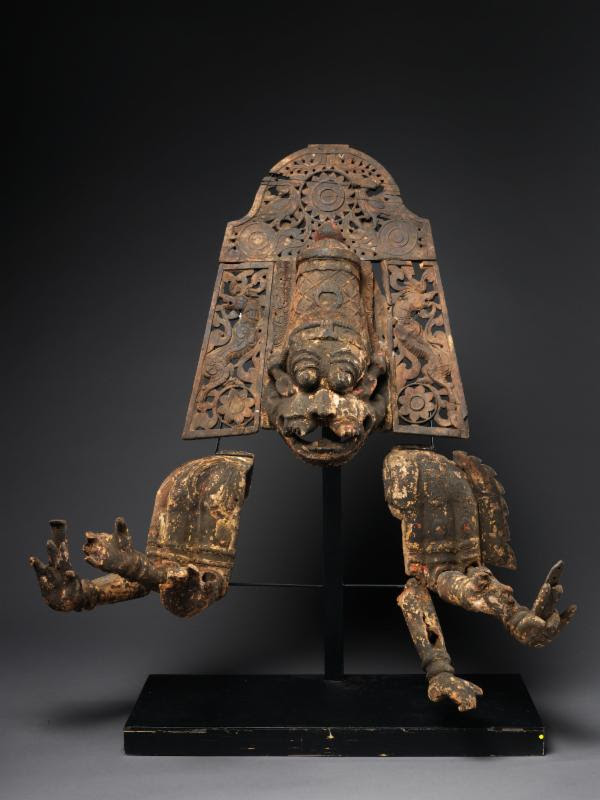Dramatic Indian Sculptural Masks to be Featured in Exhibition on Theme of Vishnu at Metropolitan Museum Exhibition dates: December 19, 2015–June 5, 2016 Our Coverage Sponsored by Paul Mayer Attitudes

Narasimha, South India (Tamil Nadu), ca. 1700-1750. Wood with cloth and polychrome. The Metropolitan Museum of Art, Purchase, The Vincent Astor Foundation and Miriam and Ira D. Wallach Foundation Gifts, 2015
Paul Mayer's luxuriously, comfortable designs keep women coming back for multiple -- even dozens -- of pairs. Classic, yet contemporary and always comfortable, his shoes are an addiction that we highly recommend. A staple of the Paul Mayer collection is the simple ballet-flat, with true ballerina construction for a perfect fit that comes in a variety of colors and materials. A cult favorite is the cozy, a flat with lavender-scent infused soles adding style and fragrance to collector's closets as Paul's designs emerge in sophisticated design incarnations season after season in the most incredible hues, textures and modern innovations in luxury footwear because we know firsthand how incredibly brilliant he is. Mayer founded the brand in 2004 with partner, Jeff Levy. All shoes in the line are manufactured in Spain’s Valencia region, along the Mediterranean coast by a skilled staff of 12 artisans. They craft each pair of shoes with an old-world attention to detail that includes in-house embroidery, quilting and stitching as well as custom tanned leather. This allows the brand to cater to each retailer’s specific demands in with timely and consistent alacrity, with orders completed in an unheard-of 3 to 5 weeks. When not in New York, Paul can be found traveling to his myriad of stores across the country meeting his loyal clientele or vacationing in his favorite spot, the Royal Hawaiian on Waikiki Beach.
Paul Mayer is a Mover and Shaker:
***
Exhibition location: Florence and Herbert Irving Asian Wing, third floor, Gallery 251
Five rare wooden sculptural masks made in India—recently acquired by The Metropolitan Museum of Art—will be the highlighted works in the special exhibition Encountering Vishnu: The Lion Avatar in Indian Temple Drama, opening at the Met on December 19. Worn by actors in dramatic plays that were presented during religious festivals in southern India, the masks represent a largely unrecorded category of late medieval devotional art from India.
The appearances of Vishnu in many guises, known as avatars, are most famously celebrated in his Ten Avatars (Dasavatar). In this exhibition, Vishnu's Narasimha (man-lion) appearance will be celebrated with several dramatic sculptural depictions. They all explore the theme of Vishnu in his man-lion form, revealing himself at the court of an evil king in response to the king's attempts to slay his own son for his unwavering devotion (bhakti) to Vishnu. A frightful battle ensues in which Narasimha finally overcomes the protective magic that the evil King Hiranyanatakam surrounds himself with, and Narasimha disembowels the king. Order is thus restored to the universe. This narrative is dramatically represented in sculptures and painting, and when staged it is given heightened drama by the wearing of these powerfully expressive masks. This temple drama, known as Hiranyanatakam, is still performed in the Kaveri delta region of Tamil Nadu, in villages around Thanjavur in southern India.
Along with the masks, the exhibition will present works in bronze, sandstone, and wood, as well as miniature paintings, lithographic devotional prints, and early photography, all of which illuminate the theme of Vishnu's divine appearances. Dating from the 6th to the 20th century, the 30 works will be drawn from the Met's collection, as well as private collections, and will include an extraordinary seated sandstone Narasimha from the sixth or seventh century.
The exhibition is made possible by The Miriam and Ira D. Wallach Foundation Fund.
The exhibition will be organized by John Guy, Florence and Herbert Irving Curator of the Arts of South and Southeast Asia.































































































